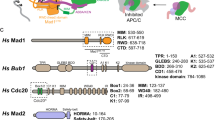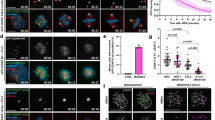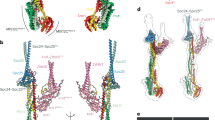Abstract
The genomic stability of all organisms depends on the precise partition of chromosomes to daughter cells. The spindle assembly checkpoint (SAC) senses unattached kinetochores and prevents premature entry to anaphase, thus ensuring that all chromosomes attach to opposite spindle poles (bi-orientation) during mitosis1. MPS1 is an evolutionarily conserved protein kinase required for the SAC and chromosome bi-orientation2,3,4. Yet, its primary cellular substrate has remained elusive. We show that fission yeast Mph1 (MPS1 homologue) phosphorylates the kinetochore protein Spc7 (KNL1/Blinkin homologue) at the MELT repeat sequences. This phosphorylation promotes the in vitro binding to the Bub1–Bub3 complex, which is required for kinetochore-based SAC activation (Mad1–Mad2–Mad3 localization) and chromosome alignment. Accordingly, a non-phosphorylatable spc7-12A mutation abolishes kinetochore targeting of Bub1–Bub3, whereas a phospho-mimetic spc7-12E mutation forces them to localize at kinetochores throughout the entire cell cycle, even in the absence of Mph1. Thus, MPS1/Mph1 kinase locating at the unattached kinetochores initially creates a mark, which is crucial for SAC activation and chromosome bi-orientation. This mechanism seems to be conserved in human cells.
This is a preview of subscription content, access via your institution
Access options
Subscribe to this journal
Receive 12 print issues and online access
$209.00 per year
only $17.42 per issue
Buy this article
- Purchase on Springer Link
- Instant access to full article PDF
Prices may be subject to local taxes which are calculated during checkout





Similar content being viewed by others
References
Musacchio, A. & Salmon, E. D. The spindle-assembly checkpoint in space and time. Nat. Rev. Mol. Cell Biol. 8, 379–393 (2007).
Hardwick, K. G., Weiss, E., Luca, F. C., Winey, M. & Murray, A. W. Activation of the budding yeast spindle assembly checkpoint without mitotic spindle disruption. Science 273, 953–956 (1996).
Abrieu, A. et al. Mps1 is a kinetochore-associated kinase essential for the vertebrate mitotic checkpoint. Cell 106, 83–93 (2001).
Winey, M. & Huneycutt, B. J. Centrosomes and checkpoints: the MPS1 family of kinases. Oncogene 21, 6161–6169 (2002).
Martin-Lluesma, S., Stucke, V. M. & Nigg, E. A. Role of Hec1 in spindle checkpoint signaling and kinetochore recruitment of Mad1/Mad2. Science 297, 2267–2270 (2002).
Araki, Y. et al. N-terminal regions of Mps1 kinase determine functional bifurcation. J. Cell Biol. 189, 41–56 (2010).
Tooley, J. & Stukenberg, P. T. The Ndc80 complex: integrating the kinetochore’s many movements. Chromosome Res. 19, 377–391 (2011).
Kemmler, S. et al. Mimicking Ndc80 phosphorylation triggers spindle assembly checkpoint signalling. EMBO J. 28, 1099–1110 (2009).
Cheeseman, I. M. & Desai, A. Molecular architecture of the kinetochore-microtubule interface. Nat. Rev. Mol. Cell Biol. 9, 33–46 (2008).
Maciejowski, J. et al. Mps1 directs the assembly of Cdc20 inhibitory complexes during interphase and mitosis to control M phase timing and spindle checkpoint signaling. J. Cell Biol. 190, 89–100 (2010).
Vigneron, S. et al. Kinetochore localization of spindle checkpoint proteins: who controls whom? Mol. Biol. Cell 15, 4584–4596 (2004).
Sliedrecht, T., Zhang, C., Shokat, K. M. & Kops, G. J. Chemical genetic inhibition of Mps1 in stable human cell lines reveals novel aspects of Mps1 function in mitosis. PLoS One 5, e10251 (2010).
Vanoosthuyse, V., Valsdottir, R., Javerzat, J. P. & Hardwick, K. G. Kinetochore targeting of fission yeast Mad and Bub proteins is essential for spindle checkpoint function but not for all chromosome segregation roles of Bub1p. Mol. Cell Biol. 24, 9786–9801 (2004).
Rischitor, P. E., May, K. M. & Hardwick, K. G. Bub1 is a fission yeast kinetochore scaffold protein, and is sufficient to recruit other spindle checkpoint proteins to ectopic sites on chromosomes. PLoS One 2, e1342 (2007).
Sharp-Baker, H. & Chen, R. H. Spindle checkpoint protein Bub1 is required for kinetochore localization of Mad1, Mad2, Bub3, and CENP-E, independently of its kinase activity. J. Cell Biol. 153, 1239–1250 (2001).
Williams, G. L., Roberts, T. M. & Gjoerup, O. V. Bub1: escapades in a cellular world. Cell Cycle 6, 1699–1704 (2007).
De Antoni, A. et al. The Mad1/Mad2 complex as a template for Mad2 activation in the spindle assembly checkpoint. Curr. Biol. 15, 214–225 (2005).
Kulukian, A., Han, J. S. & Cleveland, D. W. Unattached kinetochores catalyze production of an anaphase inhibitor that requires a Mad2 template to prime Cdc20 for BubR1 binding. Dev. Cell 16, 105–117 (2009).
Vanoosthuyse, V., Meadows, J. C., van der Sar, S. J., Millar, J. B. & Hardwick, K. G. Bub3p facilitates spindle checkpoint silencing in fission yeast. Mol. Biol. Cell 20, 5096–5105 (2009).
Lau, D. T. & Murray, A. W. Mad2 and Mad3 Cooperate to Arrest Budding Yeast in Mitosis. Curr. Biol. 22, 180–190 (2012).
Kiyomitsu, T., Murakami, H. & Yanagida, M. Protein interaction domain mapping of human kinetochore protein Blinkin reveals a consensus motif for binding of spindle assembly checkpoint proteins Bub1 and BubR1. Mol. Cell Biol. 31, 998–1011 (2011).
Krenn, V., Wehenkel, A., Li, X., Santaguida, S. & Musacchio, A. Structural analysis reveals features of the spindle checkpoint kinase Bub1-kinetochore subunit Knl1 interaction. J. Cell Biol. 196, 451–467 (2012).
Bernard, P., Hardwick, K. & Javerzat, J. P. Fission yeast bub1 is a mitotic centromere protein essential for the spindle checkpoint and the preservation of correct ploidy through mitosis. J. Cell Biol. 143, 1775–1787 (1998).
Kerres, A., Jakopec, V. & Fleig, U. The conserved Spc7 protein is required for spindle integrity and links kinetochore complexes in fission yeast. Mol. Biol. Cell 18, 2441–2454 (2007).
Ito, D., Saito, Y. & Matsumoto, T. Centromere-tethered Mps1 pombe homolog (Mph1) kinase is a sufficient marker for recruitment of the spindle checkpoint protein Bub1, but not Mad1. Proc. Natl Acad. Sci. USA 109, 209–214 (2011).
Taylor, S. S., Ha, E. & McKeon, F. The human homologue of Bub3 is required for kinetochore localization of Bub1 and a Mad3/Bub1-related protein kinase. J. Cell Biol. 142, 1–11 (1998).
Taylor, S. S. & McKeon, F. Kinetochore localization of murine Bub1 is required for normal mitotic timing and checkpoint response to spindle damage. Cell 89, 727–735 (1997).
Cheeseman, I. M. et al. A conserved protein network controls assembly of the outer kinetochore and its ability to sustain tension. Genes Dev. 18, 2255–2268 (2004).
Hiraoka, Y., Toda, T. & Yanagida, M. The NDA3 gene of fission yeast encodes β-tubulin: a cold-sensitive nda3 mutation reversibly blocks spindle formation and chromosome movement in mitosis. Cell 39, 349–358 (1984).
London, N., Ceto, S., Ranish, J. A. & Biggins, S. Phosphoregulation of Spc105 by Mps1 and PP1 regulates Bub1 localization to kinetochores. Curr. Biol. 22, 900–906 (2012).
Shepperd, L. A. et al. Phosphodependent recruitment of Bub1 and Bub3 to Spc7/KNL1 by Mph1 kinase maintains the spindle checkpoint. Curr. Biol. 22, 891–899 (2012).
Maldonado, M. & Kapoor, T. M. Constitutive Mad1 targeting to kinetochores uncouples checkpoint signalling from chromosome biorientation. Nat. Cell. Biol. 13, 475–482 (2011).
Tange, Y. & Niwa, O. Schizosaccharomyces pombe Bub3 is dispensable formitotic arrest following perturbed spindle formation. Genetics 179, 785–792 (2008).
Windecker, H., Langegger, M., Heinrich, S. & Hauf, S. Bub1 and Bub3 promote the conversion from monopolar to bipolar chromosome attachment independently of shugoshin. EMBO Rep. 10, 1022–1028 (2009).
Maure, J. F., Kitamura, E. & Tanaka, T. U. Mps1 kinase promotes sister-kinetochore bi-orientation by a tension-dependent mechanism. Curr. Biol. 17, 2175–2182 (2007).
Santaguida, S., Tighe, A., D’Alise, A. M., Taylor, S. S. & Musacchio, A. Dissecting the role of MPS1 in chromosome biorientation and the spindle checkpoint through the small molecule inhibitor reversine. J. Cell Biol. 190, 73–87 (2010).
Shimogawa, M. M. et al. Mps1 phosphorylation of Dam1 couples kinetochores to microtubule plus ends at metaphase. Curr. Biol. 16, 1489–1501 (2006).
Kawashima, S. A., Yamagishi, Y., Honda, T., Ishiguro, K. & Watanabe, Y. Phosphorylation of H2A by Bub1 prevents chromosomal instability through localizing shugoshin. Science 327, 172–177 (2010).
Shah, J. V. et al. Dynamics of centromere and kinetochore proteins; implications for checkpoint signaling and silencing. Curr. Biol. 14, 942–952 (2004).
Howell, B. J. et al. Spindle checkpoint protein dynamics at kinetochores in living cells. Curr. Biol. 14, 953–964 (2004).
Zich, J. et al. Kinase activity of fission yeast Mph1 Is required for Mad2 andMad3 to stably bind the anaphase promoting complex. Curr. Biol. 22, 296–301 (2012).
Kiyomitsu, T., Obuse, C. & Yanagida, M. Human Blinkin/AF15q14 is required for chromosome alignment and the mitotic checkpoint through direct interaction with Bub1 and BubR1. Dev. Cell 13, 663–676 (2007).
Acknowledgements
We thank S. Hauf for critical reading of the manuscript and for yeast strains, and all of the members of our laboratory for their valuable support and discussion. This work was supported in part by JSPS Research Fellowships and Grant-in-Aid for Research Activity Start-up (to Y.Y.), the Global COE Program and a Grant-in-Aid for Specially Promoted Research (to Y.W.) from the Ministry of Education, Culture, Sports, Science and Technology of Japan.
Author information
Authors and Affiliations
Contributions
Most experiments were performed by Y.Y. except those in Fig. 3 and Supplementary Fig. S4, which were performed by C.Y. and Y.T. Experimental design and interpretation of data were conducted by all authors. Y.W. supervised the project and Y.Y. and Y.W. wrote the paper.
Corresponding author
Ethics declarations
Competing interests
The authors declare no competing financial interests.
Supplementary information
Supplementary Information
Supplementary Information (PDF 1718 kb)
Supplementary Table 1
Supplementary Information (XLSX 50 kb)
Rights and permissions
About this article
Cite this article
Yamagishi, Y., Yang, CH., Tanno, Y. et al. MPS1/Mph1 phosphorylates the kinetochore protein KNL1/Spc7 to recruit SAC components. Nat Cell Biol 14, 746–752 (2012). https://doi.org/10.1038/ncb2515
Received:
Accepted:
Published:
Issue Date:
DOI: https://doi.org/10.1038/ncb2515
This article is cited by
-
MAPK-dependent control of mitotic progression in S. pombe
BMC Biology (2024)
-
Principles and dynamics of spindle assembly checkpoint signalling
Nature Reviews Molecular Cell Biology (2023)
-
Kinetochore component function in C. elegans oocytes revealed by 4D tracking of holocentric chromosomes
Nature Communications (2023)
-
Tfs1, transcription elongation factor TFIIS, has an impact on chromosome segregation affected by pka1 deletion in Schizosaccharomyces pombe
Current Genetics (2023)
-
Recruitment of two Ndc80 complexes via the CENP-T pathway is sufficient for kinetochore functions
Nature Communications (2022)



